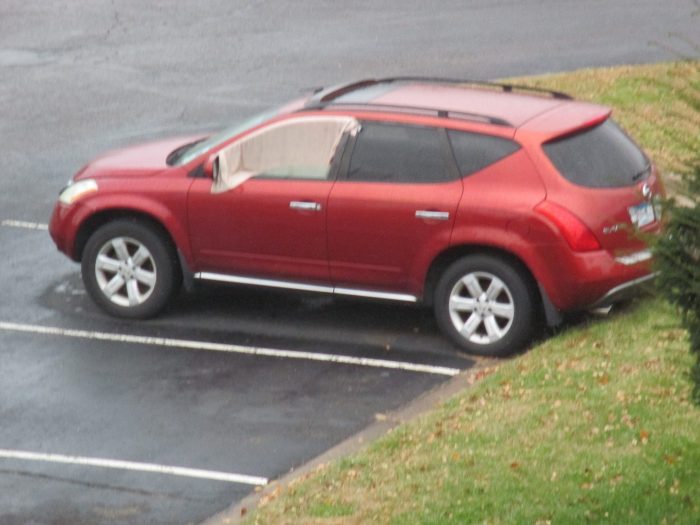At my apartment complex, this red vehicle, pictured here, has been parked in the lot for over a year.
It has two flat tires and a broken driver’s side window. Days, weeks, months have gone by, and still, here it sits. There never seems to be a human owner. I’ve never seen someone working under the hood, attempting to fix it.
It just sits abandoned, motionless, unused in the parking lot—day after day.
It got me to thinking about dysfunction and how we keep it in our lives.
It can probably be traced to the beliefs we tell ourselves. We do everything we can to make magical thinking happen, to actualize our fairytale: “happily ever after,” even if we’re dying in the process.
“It’s not that bad.”
Welcome to, perhaps, our first rationalization. Is it abuse? Is it dysfunction? Is it addiction? What is it?
Whatever it is, we try to tell ourselves it’s somewhat okay. No, it’s not perfect; no, it’s not a happy existence. No, it’s not the healthiest dynamic, but…“It’s not that bad.”
Let’s return to the red vehicle. Looking at the photo, yes, it looks like a car that is enough of a car. But is it getting us anywhere, doing what vehicles are designed to do? Are we stranded in our own parking lots, maybe, looking like we’re perfectly fine sitting in our spots?
It’s acceptable; we belong here, we tell ourselves.
But do we, really?
Here’s something unflattering about human nature: we will often tolerate bad, unhealthy, dangerous, and dysfunctional things, simply because, “It’s not that bad.” We aren’t focused on the highest good, on the greatest potential of what could be. Instead, we settle.
“It still works…somewhat.”
Also, sometimes known as: “I can fix it.”
Looking at this red vehicle as it sat for over a year in the parking lot, I could see how it, indeed, could still work…somewhat. Yes, two of the tires were flat, but that could be fixed. Pump a little air into them, or, better yet, replace them with new tires! And what about that broken driver’s side window? That was fixable, right? Just put in a new window and presto!
At first glance, the vehicle doesn’t look hopeless—it’s a fixer upper, and who doesn’t love that?
I have no idea just what, exactly, was wrong with the car. The engine could have been shot to oblivion. Or maybe there was no engine at all. Perhaps someone absconded with it in the middle of the night and had abandoned it here, in my parking lot.
Appearances can be deceiving. Just how broken down was this thing?
We can, likewise, find ourselves in similar situations in our own lives. How broken down is our thing—our relationships, our physical and mental health, our finances? Our way of being in the world?
Just like the red car, we can try to talk ourselves into the “fixable-ness” of that thing. It works enough. It just needs some attention, a new part, and then good as new! If we just try, maybe get a self-help book, or a new haircut, if we do this or that—then things will be great.
Those things are fine, but they are only a Band-Aid, not a permanent solution. They are the towel stuffed into the space of the broken window.
We try to convince ourselves that the current state—whether it’s totally malfunctioning or kind of fixed through our meager efforts—works well enough for us.
But, again, we go back to the car. The flat tires did not bring anyone to any destination. They only kept the vehicle in one place. The towel could not keep nature out. Minnesota winters, with Minnesota snow, for starters? And who knows? Perhaps there’s now a family of squirrels nesting in the car seats.
What remains in our lives just because, “It still works…somewhat,” and “I can fix it?”
“If it’s gone, I’ll miss it.”
I don’t think we fully understand just how affected we are by the fear of being without.
So, we’ll keep something broken and dysfunctional in our lives. We do it with marriages, friendships, and other relationships. We do it with habits and addictions that don’t help our lives.
We believe that once that “thing” is gone from our lives, we will be bereft. Therefore, we hang on.
In tandem with the thought of, “If it’s gone, I’ll miss it,” lies two more:
“If it’s gone, what will other people say?” and “If it’s gone, nothing will ever fill its place.”
These two things are part of our worst-case scenario. Other peoples’ views of us, and confronting what we believe to be our personal void are both scary things to have to face.
Again, I don’t know the red vehicle’s backstory. I don’t know who was involved or what their decisions were apart from what I saw: a non-working car. It’s not my business to know exactly what happened. Still, as a human being, that doesn’t stop our curiosity or opinions. We all have them. Each of us, whether we’re the broken vehicle owner or the curious onlooker, need to assess, for ourselves, why it’s so important.
What is it about image and perception that keeps us stuck in disease, dysfunction, and harm? What is it that keeps us putting up with something that is not working?
“Other people” do not have to live with the consequences of our broken thing. We pay the full price; they don’t.
And, concerning the void issue—fearing it and doing all we can to avoid it—we need to challenge ourselves with what’s behind our decision not to let go of something that is stalled, at best, and harmful, at worst.
But, just as I thought the red vehicle had finished providing its lessons, I received another. For, after more than year of it sitting in the same parking spot, one day, it was gone. Just like that.
And in its place? Sometimes, it’s another car; sometimes, it’s an empty space. But there’s movement, not just change. There’s evidence of life carrying on.
Life carries on. And you and I do have a say as to how it carries on.







Read 0 comments and reply